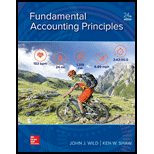
A
Concept Introduction:
A balance sheets represents the financial position of a business in terms of its assets, liabilities and shareholder's equity.
Assets:
The assets can be defined as the things that are resources owned by the owner of the business or the company which have future economic value. Example cash, investment, equipment etc.
Liabilities:
The liabilities can be defined as the sum or the total of short-term i.e. current liabilities and long-term i.e. long-term liabilities. The short-term and long-term liabilities are the debts or obligations which needs to be paid on a later decided date.
Equity:
Equity can be defined as the capital invested by the shareholders of the company plus all the
To Identify:
The amounts (in millions of Korean won) of Samsung's 2017 −
(1) Assets,
(2) Liabilities
(3) Equity
B
Concept Introduction:
Balance sheet:
A balance sheets represents the financial position of a business in terms of its assets, liabilities and shareholder's equity.
Assets:
The assets can be defined as the things that are resources owned by the owner of the business or the company which have future economic value. Example cash, investment, equipment etc.
Liabilities:
The liabilities can be defined as the sum or the total of short-term i.e. current liabilities and long-term i.e. long-term liabilities. The short-term and long-term liabilities are the debts or obligations which needs to be paid on a later decided date.
Equity:
Equity can be defined as the capital invested by the shareholders of the company plus all the retained earnings as well as the including the preferred share capital.
To prove:
For Samsung for the year 2017.
Want to see the full answer?
Check out a sample textbook solution
Chapter 1 Solutions
FUND.ACCT.PRIN.(LOOSELEAF)-W/ACCESS
- I need help solving this general accounting question with the proper methodology.arrow_forwardPlease provide the solution to this financial accounting question with accurate financial calculations.arrow_forward(a) The data in the table below has been collected by John Akoth to appraise the performance of four asset management firms: Fund 1 Fund 2 Fund 3 Fund 4 Market Index Return 6.45% 8.96% 9.44% 5.82% 7.60% Beta 0.88 1.02 1.36 0.8 1 Standard Deviation 2.74% 4.54% 3.72% 2.64% 2.80% Required If the risk-free rate of return for the relevant period is 3%, calculate the following: (i) Ex post alpha ratio. (ii) Treynor measure. (iii) Sharpe ratio. (iv) M2. (v) Rank the funds using a radar chart and state which one you would select.arrow_forward
- Do fast answer general accounting questionarrow_forwardThe Bluebird Company has annual sales of $6,800, total debt of $2,200, total equity of $3,400, and a profit margin of 7.5 percent. What is the return on assets? a. 7.25 percent b. 8.96 percent c. 10.18 percent d. 9.11 percent e. 11.45 percentarrow_forwardCan you demonstrate the accurate method for solving this financial accounting question?arrow_forward
- Can you help me solve this general accounting problem using the correct accounting process?arrow_forwardI need guidance with this general accounting problem using the right accounting principles.arrow_forwardWhat were the equivalent units for conversion costs in the Finishing Department for the month?arrow_forward

 AccountingAccountingISBN:9781337272094Author:WARREN, Carl S., Reeve, James M., Duchac, Jonathan E.Publisher:Cengage Learning,
AccountingAccountingISBN:9781337272094Author:WARREN, Carl S., Reeve, James M., Duchac, Jonathan E.Publisher:Cengage Learning, Accounting Information SystemsAccountingISBN:9781337619202Author:Hall, James A.Publisher:Cengage Learning,
Accounting Information SystemsAccountingISBN:9781337619202Author:Hall, James A.Publisher:Cengage Learning, Horngren's Cost Accounting: A Managerial Emphasis...AccountingISBN:9780134475585Author:Srikant M. Datar, Madhav V. RajanPublisher:PEARSON
Horngren's Cost Accounting: A Managerial Emphasis...AccountingISBN:9780134475585Author:Srikant M. Datar, Madhav V. RajanPublisher:PEARSON Intermediate AccountingAccountingISBN:9781259722660Author:J. David Spiceland, Mark W. Nelson, Wayne M ThomasPublisher:McGraw-Hill Education
Intermediate AccountingAccountingISBN:9781259722660Author:J. David Spiceland, Mark W. Nelson, Wayne M ThomasPublisher:McGraw-Hill Education Financial and Managerial AccountingAccountingISBN:9781259726705Author:John J Wild, Ken W. Shaw, Barbara Chiappetta Fundamental Accounting PrinciplesPublisher:McGraw-Hill Education
Financial and Managerial AccountingAccountingISBN:9781259726705Author:John J Wild, Ken W. Shaw, Barbara Chiappetta Fundamental Accounting PrinciplesPublisher:McGraw-Hill Education





